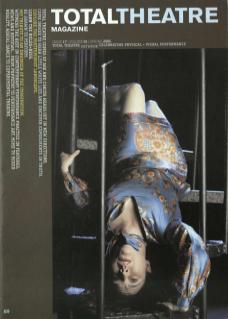The move toward a predominantly visual based culture has variously been described as heralding the final divorce between reality and representation, the opening of more inclusive means of expression and understanding, the death knell to subtleties and standards of self-expression and the triumph of the personal symbolic over the fixed terms of the verbal. What is nowhere disputed is that our cultural perception has changed and continues its evolution to absorb and reflect the increasing prominence of visual media, icons and the other trappings of the image-soaked digital age. And that the impact of these transformations onto performance, as a reflexion and distillation of cultural consciousness, as well as a mongrel, part-visual artform itself has been seismic.
But what does this mean to the people making the culture? How does it affect the resonance and range of our work; how can it inform and inspire process? Has anything really changed? Whilst academics and cultural theorists have long mulled these questions the Visions festival this year offered practising artists a bite at the cherry, building into its programme a focused space to consider from an experiential and experimental perspective some of the issues informing work both presented and planned. The emphasis of the event was squarely process-led, with discursive and practical sessions focusing on the impact of a visual inspiration to questions of methodology, approach and analysis of creative outcomes.
The range of material which radiated from this nucleus certainly reflects the saturation of contemporary performance-makers and audiences in the language of the visual. Liz Aggiss' extraordinary performative paper demonstrated, amongst (many) other things the rich and unruly plethora of visual and cultural signs unleashed by the spot-lit (or filmed) human body as an empowering exploratory field for physical practitioners. John Fox outlined his visual work as one of the most accessible means of discovering and transforming the 'poetry under your feet'; many varieties of visual art, from woodcut to pyrotechnic display to digital film, playing key roles in Welfare State's crusade to creatively empower individuals and communities' engagement with the world beyond the self. David Harradine of Fevered Sleep explored the role of photography in his work, bringing out some of the tensions innate to the image; presence vs absence; time vs stasis, opening the field for the play of these qualities against performance as a time-based, presence-predicated artform. Theatre-rites' Sue Buckmaster considered the ways in which the visual and physical (and sometimes aural) qualities of objects held in suspension rich and varied possibilities for creative experimentation whereby the play between individual and images could create a fluid and resonant process and product.
Practical workshop sessions formed a key part of the day's programme, with five different artists allowing participation in creating or analysing a visually led process, including explorations of storyboarding with Edward Taylor of Whalley Range All Stars; John Wright's comic investigation of ways to harness the power of simple visual shorthand in performance; and the collaborative possibilities offered through working with peripheral vision explored by Olu Tawio.
The sheer wealth of ideas and approaches generated by the topic for theatre-makers, not unlike the range of responses to the question of a visual-based culture as outlined above, urged me to investigate further, because against this backdrop of excitement and excess a theme seemed to be emerging. Recurrently artists seemed to be in practical dialogue with the openness of the image; its potential profligacy of meaning. Where this dialogue was effective, the visual source or outcome was characterised as 'rich', 'ambiguous' and open to play
Notably, Visions' artists consistently returned to the parameters of methodology in working with visual forms; notions of how the visual intersected with narrative, with physical context and other grounding practicalities of performance. The implied stakes were high: the very fluidity and openness to personal interpretation of the visual allows a potential slippage of meaning. This black hole of meaning where the visual can grow esoteric, or, in the opposite direction have its signification locked into the system of exchange as rigid and over-familiar symbol, formed a suggestive subtext to the day's exploration
John Fox mused, how can an artist cultivate a process both 'image conscious [and] with a mature image conscience'? Further to this we may ask, what processes can be put into play to negotiate the artistic and politically slippery surplus of visual meaning in our contemporary image-based culture?
This and other questions, queries and conundrums will be addressed in the forthcoming User's Guide publication which will draw on the day and explore further the rich palette of ideas presented and provoked. Contact users.guide@winchester.ac.uk for further details or see www.totaltheatre.org.uk

